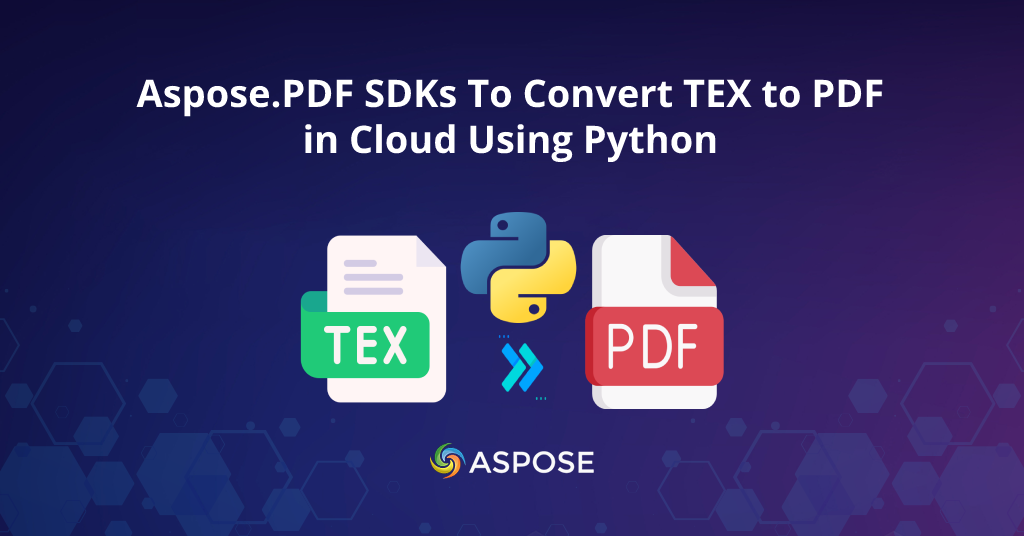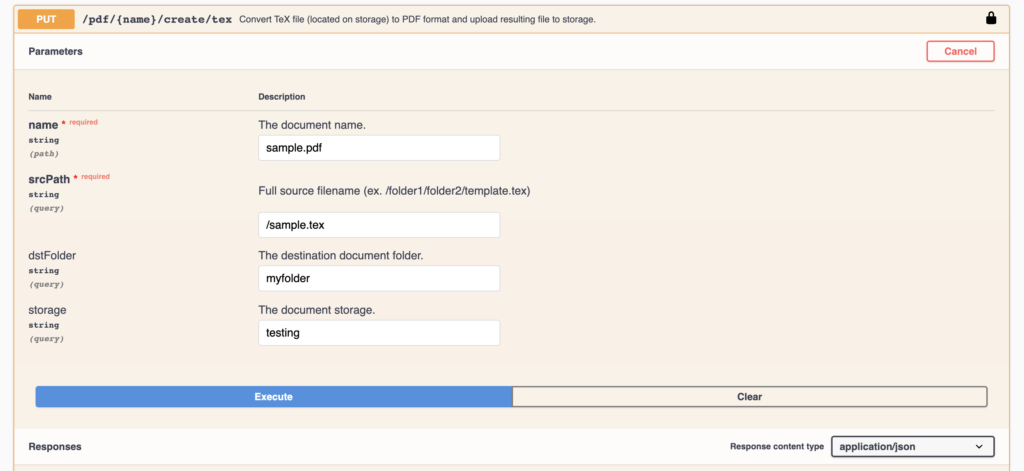An enterprise-level TEX to PDF Python library to convert TEX to PDF files efficiently. Let’s learn how to set up Aspose.PDF SDKs in Python application.

Convert TEX to PDF - TEX to PDF Python
Overview
The Aspose.PDF Cloud Product Family presents a new blog post with another interesting topic that can benefit your business. In the recent past, we have published articles such as How To Convert PDF To PPT in Cloud Using Node.js, PDF To DOC Converter – Aspose.PDF Cloud SDKs For Node.js, and some more. We have gone through Aspose.PDF software development kits for Node.js. However, this blog post is for Python developers who can come to know about setting up TEX to PDF convertor by following simple steps. Therefore, we will cover the following points to learn about converting files from TEX to PDF.
- What is a TEX file?
- Why do we need to convert TEX to a PDF file?
- How to convert TEX to a PDF file using Aspose.PDF Cloud SDKs in Python?
What is a TEX file?
TEX file is a document supported by LaTex which is a document preparation software. LaTex comes with a specific syntax that defines the structure of the document. However, the structure could be an article, application, or any letter. There are many word processing software such as Microsoft Word which follows the WYSIWYG (What you see is what you get) approach. Users structure, type the document, and visualize the content simultaneously. Whereas, LaTex word editor comes with another approach that is “WYSIWYM,” which stands for (what you see is what you mean).
LaTex text editors have a primary role in the industry as most researchers and publishers prefer TEX files. Mathematical & chemical equations are pretty easy to incorporate. There are many LaTex apps available to produce TEX files but the most popular are TeXworks, Texmaker, and MiKTeX. In addition, these applications are multiplatform and user-friendly. In the next section, we will see the business benefits of converting files from TEX to PDF. Meanwhile, you can experience the TEX to PDF Python library with real-time data using this Swagger user interface which is quite simple and user-friendly as shown in the picture below.

Convert TEX to PDF - TEX to PDF Python
Why do we need to convert TEX to a PDF file?
So far, we have covered the TEX files introduction. Now, we will look at the need to convert TEX to a PDF file. Before going ahead, Portable Document Format is the most widely used file format across the world. Due to its rich data formatting, encryption, and compression techniques, it has been the top file format amongst many others. However, we will cover the following points to complete this section.
Not WYSIWYG
Like other word processing editors, LaTex editor is not based on WYSIWYG (What you see is what you get). In the current fast-growing age, users tend to opt for efficient and robust options. Therefore, there are many PDF editors available that serve the purpose.
Difficult to edit
TEX files are hard to edit once they have been structured. In addition, it has a steep learning curve and is considered for technical persons.
Dependency
The other aspect of TEX files is that most of its features require third-party libraries which users need to find to use a particular feature.
Limited layout options
When it comes to business documents, the layout means a lot. Therefore, choosing LeTex editor will not be a great deal as it does not offer much layout freedom as other word processing software offers.
How to convert TEX to a PDF file using Aspose.PDF Cloud SDKs in Python?
So, we are all set to equip our Python application with a TEX to PDF Python library that will convert TEX to PDF files efficiently. Please visit this tutorial to know about setting up an application and retrieving API credentials( YOUR-APPSID, YOUR-APPKEY).
Once you are done with the first step mentioned above, make sure you have installed Python on your local machine.
Now, run the following commands to install the Aspose.PDF package for Python.
pip install asposepdfcloud
In addition, you can create a folder in your cloud storage for storing converted files as we have created a folder named ‘myfolder’.
After that, place a source TEX file in the root of your project as we have placed a TEX file named ‘sample.tex’ file. Then, open your main Python file, place the following code and start your server.
import asposepdfcloud
import asposepdfcloud.api_client
from asposepdfcloud import PdfApi
import shutil
source_file = "sample.tex";
source_file_path = "/sample.tex";
storage_ = "testing";
target_file = "sample.pdf";
target_file_path = "/myfolder/sample.pdf";
remote_folder = "myfolder";
local_result_file = "./result.pdf";
api_client = asposepdfcloud.api_client.ApiClient("YOUR-APPKEY","YOUR-APPSID")
pdf_api = PdfApi(api_client);
try:
#invoke Aspose.Pdf Cloud SDK API to upload TEX file to cloud
res = pdf_api.upload_file(source_file_path,file=source_file,storage_name=storage_);
#invoke Aspose.Pdf Cloud SDK to convert TEX file to PDF file in the cloud storage
response = pdf_api.put_te_x_in_storage_to_pdf(target_file,source_file,dst_folder=remote_folder,storage=storage_);
#invoke Aspose.Pdf Cloud SDK to get the converted file
response_download = pdf_api.download_file(target_file_path,storage_name=storage_, version_id='');
shutil.copyfile(response_download, local_result_file)
print('Converted TEX to PDF Successfully')
except ApiException as e:
print("Exception while calling PdfApi: {0}".format(e))
Upon a successful run, you will see a converted file stored in your remote storage and a downloaded copy of the converted file in your project’s root.
Conclusion
This is the end of this blog post. We have explored and implemented TEX to PDF Python library that is used to convert TEX to PDF files. Aspose.PDF offers SDKs for other languages such as Node.js, C#, Java and some more that you may check the docs. Moreover, there are other useful articles enlisted in the ‘Explore’ section below.
Finally, blog.aspose.cloud is in the ongoing process to write further articles in the series of Aspose.PDF Cloud Product Family. Therefore, please stay connected for regular updates. However, you can follow us on our social media accounts Facebook, LinkedIn, and Twitter.
Ask a question
Feel free to visit our forum which is very active to respond to questions and queries/discussions.
Explore
You may find the following links relevant:
- PDF To DOC Converter – Aspose.PDF Cloud SDKs For Node.js
- How To Convert PDF To PPT in Cloud Using Node.js
- PDF To Excel Using Aspose.PDF Cloud SDKs For Node.js
- HTML To PDF Converter | Aspose.PDF | File Format Converter
- How To Convert PDF File To HTML Using Aspose.PDF Cloud SDKs For Node.js
- Email Sending using Aspose.Email Cloud in Heroku Ruby on Rails